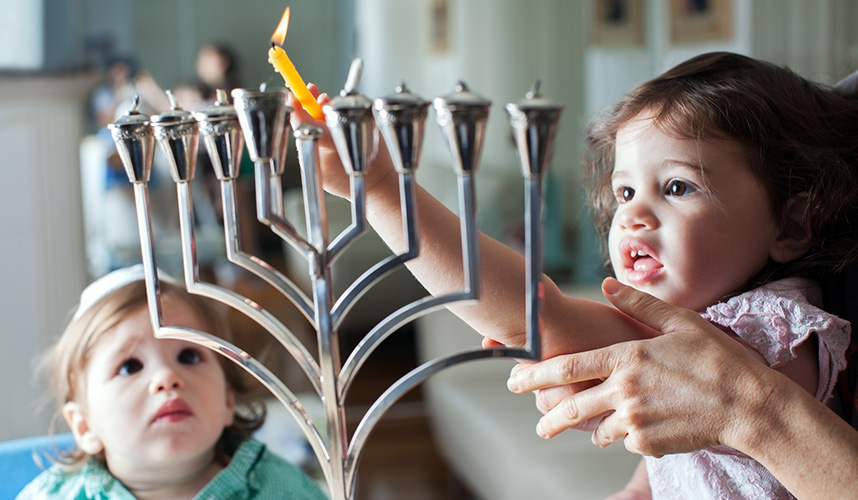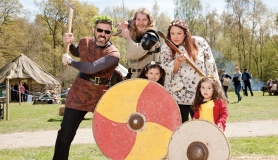You could join French children and bake gingerbread and mannala on St Nicholas day, or enjoy a festival of light like St Lucy’s Day or Hanukkah.What about a day of peaceful contemplation on Bodhi Day? Find out how others are celebrating this December and see if you can weave some of their traditions into your own family customs.
6th December – St. Nicolas Day St. Nicolas is the patron saint of Lorraine in France but St. Nicolas Day is celebrated in many European countries. Tradition states that a little donkey carries baskets filled with children’s gifts, biscuits and sweets to children’s homes. Families get ready for the saint and the donkey’s arrival, and grandparents tell stories. Perhaps the most famous is the story of three children who wandered away from home and got lost. A wicked butcher lured the cold and hungry wanderers into his shop where he salted them in a large tub. St. Nicolas arrived and saved the children, taking them home to their families. In France you can see paintings and statues of this story, and St. Nicolas became the patron saint of children. On St. Nicolas Day, spiced gingerbread biscuits and mannala (a brioche shaped like the saint) are baked. Children learn St. Nicolas songs and poems and draw and paint St. Nicolas pictures and crafts. Saint Nicolas visits schools, giving children chocolates and sometimes even a little present.
8th December – Bodhi Day, Day of Enlightenment This Buddhist festival celebrates the day Buddha experienced enlightenment under the Bodhi tree. 2,500 years ago, a young prince from Northern India called Siddhartha Gautama, sat down under a Bodhi tree after trying to achieve enlightenment through many different practices without success. He declared; “Even though the flesh falls from my bones and the bones themselves crack, I will not get up from this seat until I have attained supreme and perfect enlightenment!”. He sat in meditation for 49 days, going into deeper meditation for the last 8 days. He achieved enlightenment on the eighth day, attaining a state of calm awareness. This day invites Buddhists and others to reflect upon their lives and humbly take responsibility for them. Bodhi Day is a day to come together in celebration.
13th December – St. Lucy’s Day St. Lucy is a Sicilian saint, the patroness of the blind. Her name means ‘light’ and this is another festival of light. In Italy, her feast day is celebrated with torchlight processions and bonfires. Legend has it that St. Lucy sent her own eyes to a suitor who remarked they were beautiful, asking to be left in peace. For this reason, she is often pictured with eyeballs on a plate and Italians happily eat St. Lucy’s eye-shaped cakes and biscotti! Typical St. Lucy’s Day fare in Sicily includes potatoes or rice in the form of arancine, and cuccia, a dessert of berries and sweet ricotta. St. Lucy’s Day is celebrated across Europe, but most particularly in Scandinavia where long winter nights mean a light festival is especially welcome. In Scandinavian countries, the eldest daughter rises before dawn and dresses in a white dress with a red sash, and a crown of candles. She then serves her family traditional pastries called lussekatter (Lucy’s cats). St. Lucy processions are also held in towns, with a girl dressed as St. Lucy with her crown of candles leading the way, followed by other girls in white dresses, boys in star-decorated hats, and other children dressed as trolls, demons and old men. In Hungary, St. Lucy’s Day celebrations have a kind of trick or treat aspect, as bands of Kotylok or fortune-telling lads go from house to house singing ancient fertility chants. The Kotylok wish for hens and geese, for many eggs and bountiful blessings. If the mistress of the house welcomes the singers and gives them the traditional present of dried pears, blessings will follow. If not, legend has it the chicken population will be reduced to one blind hen!
16th December – Hanukkah Hanukkah (or Chanukah) is the Jewish Festival of Lights, celebrated over eight days and nights. The word Hanukkah translates as ‘rededication’, and the festival celebrates a famous story in Jewish history. Over 2,500 years ago Antiochus, a Syrian king, tried to make the Jewish people worship Greek gods despite the fact that The Ten Commandments forbade them to worship statues or idols. A small group of Jews rebelled, and after a three year war they recaptured Jerusalem from the Syrians, but their temple was all but destroyed. The Jews gathered together to repair the temple and they then rededicated it to God by lighting the Menorah lamp. Although there was only one jar of oil, the lamp miraculously stayed alight for eight days. In Jewish homes today, Hanukkah is celebrated by lighting one candle on the Hanukkiyah (an eight-stemmed candelabra) each day. Children’s games are a big part of Hanukkah, including spinning the dreidel (a four-sided top with Hebrew letters on the sides) for chocolate coins called gelt. Traditional Hanukkah foods are fried, such as latkes (pancakes made of potato and onion) and sufganiyot (jam-filled doughnuts). Hanukkah is one of many light-based festivals at this time of year and some of the customs, such as lighting candles, make a special addition to family traditions.
21st December – Mōdraniht Mōdraniht or ‘Mother’s Night’ is an ancient Germanic festival, a major feast celebrating the birth of the New Year. Although dates are not certain, it seemed to have been celebrated on the winter solstice, the shortest day of the year. It was the start of Yuletide, a pagan midwinter festival, which lasted several days and nights, depending on the country. Yuletide was eventually taken over by Christians as Christmas as a way of using the celebrations already in place at this time of year. The exact reason why the night was called ‘Mother’s Night’ isn’t certain, but it seems a wonderful opportunity to celebrate all mothers – make it a special feast night for you!
21st December – Yalda Shabe Yaldā, meaning ‘birthday eve’, is an Iranian festival celebrating the victory of light and goodness over darkness and evil. According to Persian mythology, the god Mithra was born at dawn on the 22nd of December to a virgin mother. Mithra symbolizes light, truth, goodness, strength, and friendship and this was the most important holiday of the year for ancient Persians. These days, Iranians celebrate Yalda by staying up into the night to ‘night gaze’, a practice which translates as Shab Chera. Favoured foods are fruits and nuts, especially pomegranates and watermelons, whose red colour invokes the crimson hues of dawn, symbolising the birth of Mithra. This is the perfect festival to get out a telescope and do a bit of night gazing!
21st December – Soyal Soyal is the 16 day solstice ceremony of Native Americans, the Hopi Indians, or The Peaceful Ones, marking the beginning of another year. Rituals are carried out to ceremonially bring the sun back from its long winter slumber and to purify the community. Prayer sticks are used during the Soyal ceremony to bless people, homes, animals, and plants. The Hopi have celebrated Soyal for generations, and they traditionally end the ceremony with a feast and a dance. Hopi Elders state that, “Soyal time is a good time to teach children to respect others, so they will continue to practice it throughout their lives.” Soyal is a time to celebrate Mother Earth, and traditionally it is a time not to dig the earth as she is joining in the Soyal ceremonies with you.
21-25 December – Pancha Ganapati Pancha Ganapati, like the Afro-American conceived earth-based festival Kwanzaa, is the Hindu answer to Christmas, created in direct response to give meaning to this time of year for Hindus. It is a festival dedicated to the five-faced elephant god, Ganesh, and combines five days of gift-giving and festivities with sacred meaning. The five days might include outings, picnics, feasts, and the exchange of cards and gifts with loved ones. A tray of sweets, fruits and incense is offered to Pancha Ganapati each day by children, and chants, songs and bhajanas are sung in praise. During each of the five days the entire family focuses upon a different sadhana or practice. On day one, the sadhana is to create a vibration of love and harmony among the immediate family, ending with a period of time in which the family sits together to share their love. The second day is devoted to creating a vibration of love and harmony among neighbours, relatives and close friends, with the third dedicated to love and harmony amongst work colleagues and business associates. On day four the family celebrate the harmony that comes from music, art, drama and the dance, enjoying these cultural things together (Ganesh is the god of culture). Finally, on the fifth day, the practice is to bring together love and harmony from all the different spheres. By this stage in the festival, there is a sense of abundant love and joyfulness, and gifts are given from the heart.







